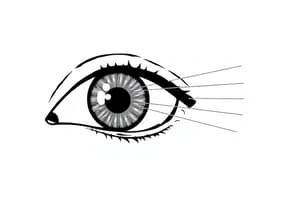Podcast
Questions and Answers
Which cranial nerve primarily innervates the lateral rectus muscle?
Which cranial nerve primarily innervates the lateral rectus muscle?
- Trochlear (CNIV)
- Oculomotor (CNIII)
- Abducens (CNVI) (correct)
- Optic (CNII)
Which muscle is not classified as one of the extraocular muscles?
Which muscle is not classified as one of the extraocular muscles?
- Medial rectus
- Superior oblique
- Inferior rectus
- Ciliary muscle (correct)
What is the primary function of the sphincter pupillae muscle?
What is the primary function of the sphincter pupillae muscle?
- Controlling eye movement
- Regulating lens curvature
- Inducing pupil mydriasis
- Inducing pupil miosis (correct)
What distinguishes the extrinsic muscles of the eye from intrinsic muscles?
What distinguishes the extrinsic muscles of the eye from intrinsic muscles?
Which muscles comprise the group known as intrinsic eye muscles?
Which muscles comprise the group known as intrinsic eye muscles?
How does the arc of contact change as an extraocular muscle contracts?
How does the arc of contact change as an extraocular muscle contracts?
Which extraocular muscle is innervated by the trochlear nerve?
Which extraocular muscle is innervated by the trochlear nerve?
What role do the intrinsic eye muscles play in vision?
What role do the intrinsic eye muscles play in vision?
Which of the following statements about the extraocular muscles is true?
Which of the following statements about the extraocular muscles is true?
How are the recti muscles of the extraocular muscles categorized?
How are the recti muscles of the extraocular muscles categorized?
What type of muscle fibers are included in the ciliary muscle?
What type of muscle fibers are included in the ciliary muscle?
Which cranial nerves are involved in the innervation of the extraocular muscles?
Which cranial nerves are involved in the innervation of the extraocular muscles?
What is the purpose of the intrinsic eye muscles?
What is the purpose of the intrinsic eye muscles?
What effect does the contraction of the extraocular muscles have on the arc of contact?
What effect does the contraction of the extraocular muscles have on the arc of contact?
Flashcards are hidden until you start studying
Study Notes
Extraocular Muscles (EOMs)
- Comprise 6 voluntary, extrinsic muscles that control eye movements.
- Divided into 4 rectus muscles and 2 oblique muscles.
Rectus Muscles
- Medial Rectus: Innervated by the oculomotor nerve (CNIII).
- Lateral Rectus: Innervated by the abducens nerve (CNVI).
- Superior Rectus: Innervated by the oculomotor nerve (CNIII).
- Inferior Rectus: Also innervated by the oculomotor nerve (CNIII).
Oblique Muscles
- Superior Oblique: Innervated by the trochlear nerve (CNIV).
- Inferior Oblique: Innervated by the oculomotor nerve (CNIII).
Intrinsic Eye Muscles
- Responsible for controlling lens and pupil movements, important for vision accommodation.
- Comprise 3 smooth muscle types:
- Ciliary Muscle: Contains longitudinal, radial, and circular fibres.
- Dilator Pupillae: Induces mydriasis (dilation) via sympathetic innervation.
- Sphincter Pupillae: Induces miosis (constriction) via parasympathetic innervation.
Origins and Insertions of EOMs
- Start at the orbit, bones, or connective tissue structures.
- Insert onto the globe of the eye, facilitating movement.
Muscle Characteristics
- Insertion width varies across different EOMs.
- Muscle and tendon length adjustments occur during contraction.
- Arc of contact: Formed between muscle insertion center and tangential point on the sclera.
- Arc length changes with muscle contraction, impacting eye movement dynamics.
Extraocular Muscles (EOMs)
- Comprise 6 voluntary, extrinsic muscles that control eye movements.
- Divided into 4 rectus muscles and 2 oblique muscles.
Rectus Muscles
- Medial Rectus: Innervated by the oculomotor nerve (CNIII).
- Lateral Rectus: Innervated by the abducens nerve (CNVI).
- Superior Rectus: Innervated by the oculomotor nerve (CNIII).
- Inferior Rectus: Also innervated by the oculomotor nerve (CNIII).
Oblique Muscles
- Superior Oblique: Innervated by the trochlear nerve (CNIV).
- Inferior Oblique: Innervated by the oculomotor nerve (CNIII).
Intrinsic Eye Muscles
- Responsible for controlling lens and pupil movements, important for vision accommodation.
- Comprise 3 smooth muscle types:
- Ciliary Muscle: Contains longitudinal, radial, and circular fibres.
- Dilator Pupillae: Induces mydriasis (dilation) via sympathetic innervation.
- Sphincter Pupillae: Induces miosis (constriction) via parasympathetic innervation.
Origins and Insertions of EOMs
- Start at the orbit, bones, or connective tissue structures.
- Insert onto the globe of the eye, facilitating movement.
Muscle Characteristics
- Insertion width varies across different EOMs.
- Muscle and tendon length adjustments occur during contraction.
- Arc of contact: Formed between muscle insertion center and tangential point on the sclera.
- Arc length changes with muscle contraction, impacting eye movement dynamics.
Studying That Suits You
Use AI to generate personalized quizzes and flashcards to suit your learning preferences.




